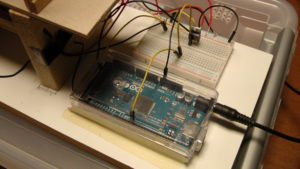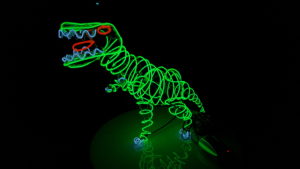For the last week of the project, I built a structure out of craft sticks and a thin plank of wood. The structure extends up above the cylinder to hold the upper end of the axle, which passes up through the center of the cylinder, in place. I then built a circuit to enable an Arduino to control the RGB LED ring and the motor.
Below is a picture of the structure that I built around the cylinder:

Here is a picture of the circuit that I put together to power and control the LEDs and the motor using an Arduino and a 5V power supply:

I wrote a program that executes on the Arduino to control the LEDs and the motor. The LEDs are initialized to random colors. Over time, the color pattern rotates around the ring and the colors tend to change over time. The motor changes speed randomly. At the end of every random time interval, a random target speed is selected, and the motor’s current speed drifts towards the new target speed.




